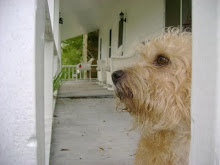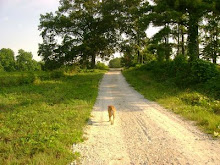This is not some badge of honor for a kill, it's an unfortunate find. I'm no hunter, neither is Sis. So when I stumbled upon the dead-body of this White-Tailed Deer while walking last February it wasn't a happy moment. Tucked deep into shrubs that define the property line, he lay on his back, snout pointed to the sky, dead. We guessed he'd been wounded by hunters and chose this place to die. We checked to see if a 'removal' type service exists. It doesn't.

Next morning I walked by the spot again. What a shock to see much of his body had disappeared. By the fourth morning all that was left is what you see in the above photo. Look closely, you can see the antlers hidden in the shrubs. That's where they've been ever since, until last weekend when Mr. R. brought them out and placed them on the cottage fence.

Antler development is important to many hunters and deer observers. Buck antler development is controlled by age, nutrition, and genetics. However, in Georgia genetics do not appear to be an important factor. For most deer in this state, age is the single most limiting factor for antler development, followed by nutrition. Under heavy hunting pressure, bucks simply do not live long enough to produce large antlers. In parts of the Lower Coastal Plain and Mountains, bucks live much longer but nutrition levels often are poor which limits antler development. Likewise, poor nutrition also occurs in the Piedmont when deer herds get so large that their food supply is reduced in quality or quantity resulting in poor antler growth. So sad!
 Next morning I walked by the spot again. What a shock to see much of his body had disappeared. By the fourth morning all that was left is what you see in the above photo. Look closely, you can see the antlers hidden in the shrubs. That's where they've been ever since, until last weekend when Mr. R. brought them out and placed them on the cottage fence.
Next morning I walked by the spot again. What a shock to see much of his body had disappeared. By the fourth morning all that was left is what you see in the above photo. Look closely, you can see the antlers hidden in the shrubs. That's where they've been ever since, until last weekend when Mr. R. brought them out and placed them on the cottage fence. Antler development is important to many hunters and deer observers. Buck antler development is controlled by age, nutrition, and genetics. However, in Georgia genetics do not appear to be an important factor. For most deer in this state, age is the single most limiting factor for antler development, followed by nutrition. Under heavy hunting pressure, bucks simply do not live long enough to produce large antlers. In parts of the Lower Coastal Plain and Mountains, bucks live much longer but nutrition levels often are poor which limits antler development. Likewise, poor nutrition also occurs in the Piedmont when deer herds get so large that their food supply is reduced in quality or quantity resulting in poor antler growth. So sad!
Antler development is important to many hunters and deer observers. Buck antler development is controlled by age, nutrition, and genetics. However, in Georgia genetics do not appear to be an important factor. For most deer in this state, age is the single most limiting factor for antler development, followed by nutrition. Under heavy hunting pressure, bucks simply do not live long enough to produce large antlers. In parts of the Lower Coastal Plain and Mountains, bucks live much longer but nutrition levels often are poor which limits antler development. Likewise, poor nutrition also occurs in the Piedmont when deer herds get so large that their food supply is reduced in quality or quantity resulting in poor antler growth. So sad!






































Great blog!
ReplyDelete<3 Lindsay
Thanks Mold Owings Mills.
ReplyDeleteHow about a link to the Ramsay post itself. You are torturing me.
ReplyDeletelol
xx